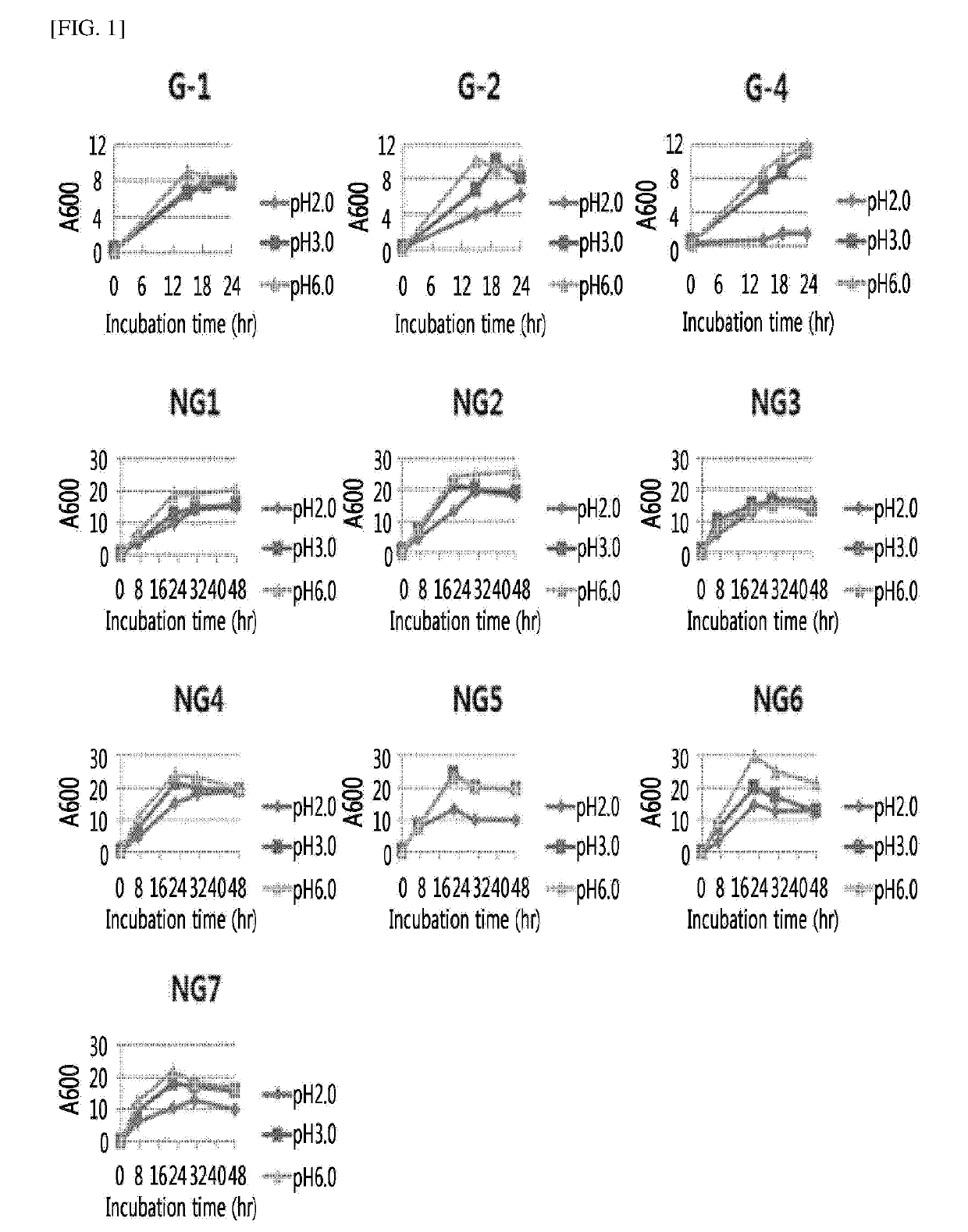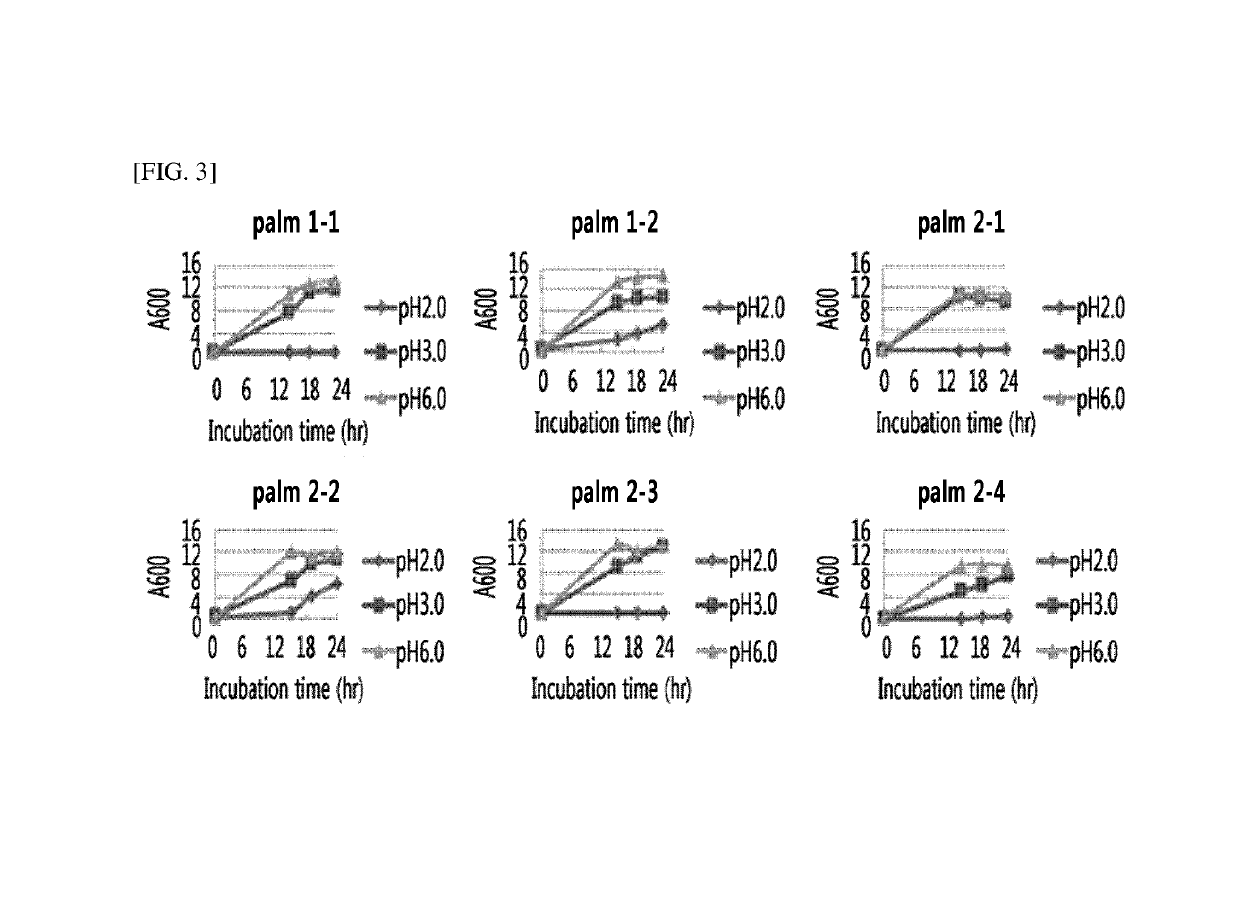Pichia kudriavzevii NG7 microorganism and uses thereof
a microorganism and a technology of pichia kudriavzevii, applied in the field of pichia kudriavzevii ng7 microorganisms, can solve the problems of increasing the production cost of lactic acid, inhibiting the growth of a given strain, and increasing the price of crop products such as corn and sugarcane, so as to achieve excellent heat resistance and acid resistance, and efficient production of lactic acid
- Summary
- Abstract
- Description
- Claims
- Application Information
AI Technical Summary
Benefits of technology
Problems solved by technology
Method used
Image
Examples
example 1
of Novel Yeasts with Acid Resistance
[0090]For the identification of novel yeasts with acid resistance, various samples (soils within the territory of the Korean Research Institute of Bioscience and Biotechnology (KRIBB) in Daejeon, grape skins, peach skins, palm by-products, and palm by-product compost, etc.) were collected. The collected sample (10 g) was added into sterile distilled water (40 mL) and mixed by vortexing for an hour. Then, the supernatant was diluted stepwise and plated on a solid medium containing antibiotic for inhibition of bacterial growth, YMPS (yeast extract (0.3%), malt extract (0.3%), peptone (0.5%), glucose (1%), penicillin (50 mg / L), and streptomycin (50 mg / L)), cultured at 30° C. for 48 hours, and secured the microorganism which formed yeast-type colonies instead of fungal spore-type.
[0091]For the species analysis of the isolated microorganisms, after culturing each of the microorganisms in 3 mL of YMPS liquid medium with shaking at 30° C. at a rate of 18...
example 2
of Acid Resistance of Isolated Microorganisms
[0096]For the selection of microorganisms with acid resistance among the microorganisms isolated in Example 1, the microorganisms were cultured on YPD liquid media (yeast extract (1%), peptone (2%), and glucose (2%)) having a pH adjusted to pH 2.0, 3.0, and 6.0, respectively, at 30° C. at a rate of 180 rpm for 48 hours, and the growth curves were analyzed (FIGS. 1 to 4). As a result, the growth for all of the yeast microorganisms was similar at pH 3.0 and pH 6.0, and differences among microorganisms were confirmed at pH 2.0. Most of the yeast microorganisms isolated from grape skin and peach skin showed a rapid growth at pH 2.0, however, with respect to the microorganisms isolated from palm by-products and palm by-product compost, only a few microorganisms were shown to grow at pH 2.0.
example 3
of Microorganisms with Lactic Acid Resistance
[0097]The 8 kinds of microorganisms which were shown to have excellent acid resistance in Example 2 were selected and their lactic acid resistance was examined
[0098]The isolated microorganisms were inoculated into YPD liquid media (yeast extract (1%), peptone (2%), and glucose (2%)) containing 0%, 4%, 5%, and 6% lactic acid, and cultured with shaking at 30° C. at a rate of 180 rpm for 48 hours, and the growth curves according to time were analyzed.
[0099]As a result, it was confirmed that all of the microorganisms showed a growth in media containing 6% lactic acid, and specifically among them, 2-2, NG1, and NG7 microorganisms showed higher resistance to 6% lactic acid than other microorganisms (FIG. 5). Among the three kinds of microorganisms, the 2-2 and NG7 microorganisms were classified as Pichia kudriavzevii microorganisms by the result of nucleotide sequence analysis of ribosomal RNA. However, the 2-2 microorganism showed a homology o...
PUM
| Property | Measurement | Unit |
|---|---|---|
| temperature | aaaaa | aaaaa |
| temperature | aaaaa | aaaaa |
| temperature | aaaaa | aaaaa |
Abstract
Description
Claims
Application Information
 Login to View More
Login to View More - R&D
- Intellectual Property
- Life Sciences
- Materials
- Tech Scout
- Unparalleled Data Quality
- Higher Quality Content
- 60% Fewer Hallucinations
Browse by: Latest US Patents, China's latest patents, Technical Efficacy Thesaurus, Application Domain, Technology Topic, Popular Technical Reports.
© 2025 PatSnap. All rights reserved.Legal|Privacy policy|Modern Slavery Act Transparency Statement|Sitemap|About US| Contact US: help@patsnap.com



